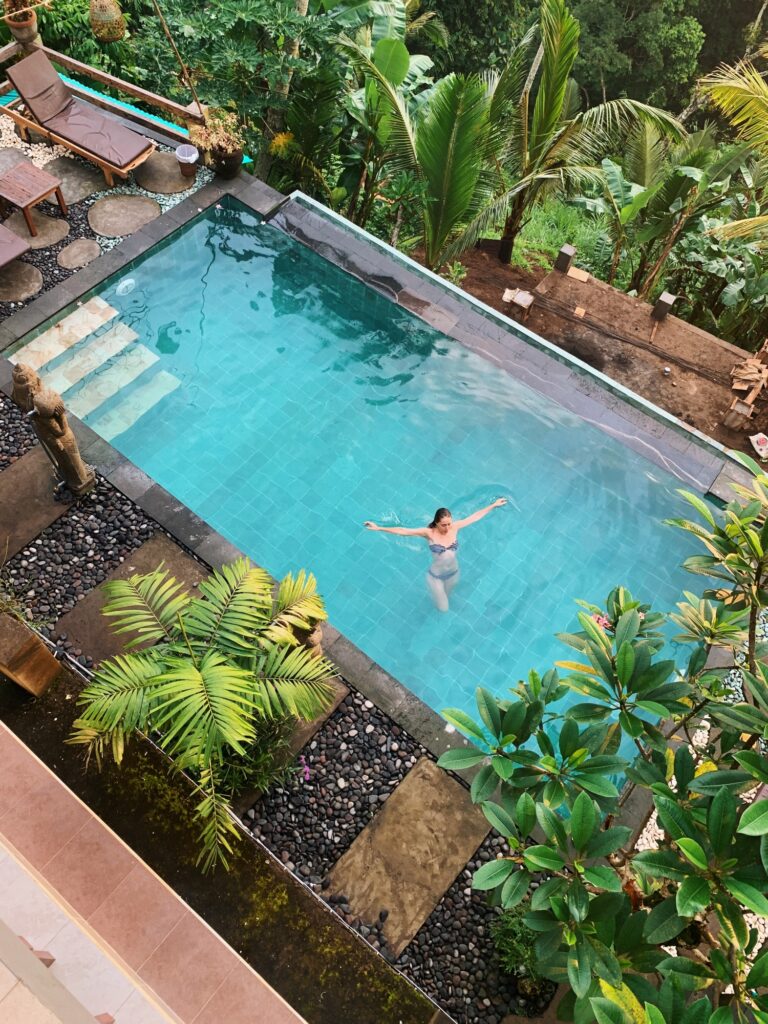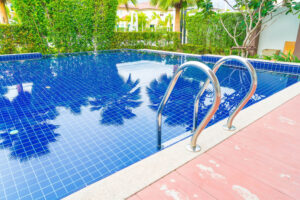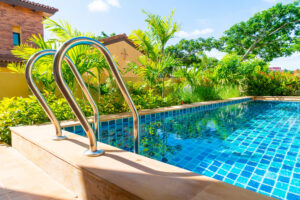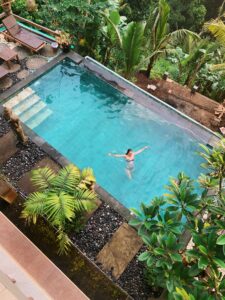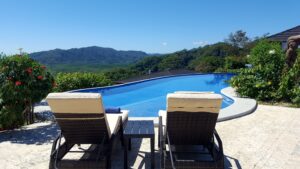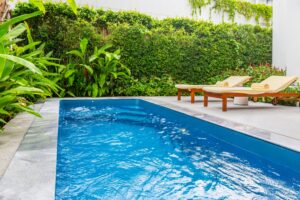Looking to transform your backyard into a relaxing oasis without the commitment of a full-sized pool? This plunge pool buying guide is the perfect solution for homeowners with limited space who still want to enjoy the benefits of water relaxation.
These compact swimming features have gained popularity in recent years for good reason – they’re easier to maintain, more affordable to run year-round, and can fit beautifully into almost any outdoor space.
A plunge pool is a small, compact swimming pool designed primarily for relaxation and cooling off, with a consistent depth throughout rather than varying shallow and deep ends.
Unlike traditional swimming pools that require extensive space and maintenance, plunge pools provide a cost-effective alternative that doesn’t sacrifice on enjoyment. They’re typically between 10-15 feet in length and can be installed in areas where standard pools simply wouldn’t fit.
We understand that choosing the right plunge pool involves weighing several factors including materials, size, style, and installation requirements.
Whether you’re looking for a prefabricated option that can be quickly installed or planning a custom design that perfectly complements your landscape, this guide will help you navigate the options available in 2025
Here’s what you need to know to compare materials, sizes, features, and purchase options confidently:
- What to know before buying a plunge pool online
- Key factors to compare before you buy
- Choosing plunge pool installation and preparation
- Understanding plunge pool pricing and lifetime costs
- How to buy a plunge pool online with confidence
By the end of this article, you’ll have the knowledge needed to make an informed decision about the perfect plunge pool for your backyard retreat.
What to know before buying a plunge pool online
Shopping for a plunge pool online requires careful consideration of several key factors. Before making this significant investment, you’ll want to understand the differences between pool types, installation options, and common purchasing pitfalls.
The difference between plunge pools and traditional pools
Plunge pools are significantly smaller than traditional swimming pools, typically measuring between 6-10 feet in length and width. Their primary purpose is relaxation and cooling off rather than swimming laps.
Traditional pools are designed for exercise and recreation, often measuring 30+ feet long, while plunge pools focus on comfort and convenience in a compact space.
Depth is another key difference. Traditional pools usually have varying depths (3-8 feet), while plunge pools maintain a consistent depth of about 4-5 feet – deep enough to immerse yourself but not for diving.
Water volume is dramatically different too. A plunge pool typically holds 4,000-8,000 gallons compared to a traditional pool’s 15,000-30,000 gallons, resulting in lower maintenance costs and chemical usage.
When a plunge pool makes more sense than a full-size model
Space constraints are the most common reason people choose plunge pools. If your yard is small or you want to preserve outdoor space for other activities, a plunge pool is ideal.
Budget considerations matter too. Plunge pools typically cost $20,000-$35,000 installed, whereas traditional pools often exceed $50,000. The smaller water volume also means lower ongoing maintenance expenses.
Usage patterns should influence your decision. If you primarily want a place to cool off and relax rather than swim laps, a plunge pool provides these benefits without wasted space.
Installation timeline is shorter for plunge pools. Many prefabricated models can be installed in days rather than the weeks or months required for traditional pools.
For homes with older residents or those seeking therapeutic benefits, plunge pools offer easier entry and exit while still providing cooling relief.
Indoor, outdoor, above-ground or inground?
Outdoor plunge pools are most common and typically easier to install. They provide a refreshing backyard retreat without overwhelming the landscape. Consider privacy, sun exposure, and proximity to your home.
Indoor plunge pools offer year-round use regardless of weather conditions. However, they require proper ventilation, moisture control, and more extensive structural considerations that increase costs.
Inground plunge pools create a seamless look that integrates with your landscape. These permanent installations typically increase property value but involve excavation and more complex installation.
Above-ground plunge pools offer flexibility and lower installation costs. These can be moved if needed and may not require permits in some areas. Many prefab models are designed specifically for above-ground installation.
Climate should influence your decision – indoor or heated options work better in colder regions, while outdoor models are perfect for warm climates.
Common myths and mistakes buyers should avoid
Myth #1: All plunge pools are the same. In reality, materials, filtration systems, and features vary dramatically between manufacturers. Research specific brands and read customer reviews before purchasing.
Mistake: Underestimating installation requirements. Even prefab plunge pools need proper site preparation, access for delivery equipment, and often professional installation. Factor these costs into your budget.
Myth #2: Plunge pools don’t need maintenance. While they require less maintenance than traditional pools, they still need regular cleaning, chemical balancing, and filtration to remain safe and enjoyable.
Mistake: Choosing based only on price. The cheapest option often leads to higher long-term costs. Invest in quality materials and proper installation for longevity.
Myth #3: You can install it yourself. Unless you have significant construction experience, professional installation is recommended to ensure structural integrity, proper plumbing, and electrical safety.
Key factors to compare before you buy
Before investing in a plunge pool, you need to carefully evaluate several critical factors that will impact your satisfaction with the purchase. Comparing these elements will help ensure you select a pool that fits your space, meets your needs, and stays within your budget.
Size and depth: What’s ideal for your space and use
The right dimensions for your plunge pool depend on your available space and intended use. Most plunge pools range from 6 to 14 feet in length and 6 to 10 feet in width. For relaxation purposes, a smaller pool around 6-8 feet may suffice.
For exercise, we recommend at least 10-12 feet in length to allow for resistance swimming. Depth typically ranges from 4 to 7 feet, with 4-5 feet being most common for general use.
Consider your yard dimensions carefully. A plunge pool should leave at least 3 feet of decking space around all sides. Many homeowners with limited space opt for plunge pools precisely because they offer water enjoyment without consuming the entire yard.
Urban properties especially benefit from compact designs that still deliver the full pool experience in a fraction of the space.
Material options: Concrete, fiberglass, precast
Plunge pools come in three primary materials, each with distinct advantages:
Fiberglass Plunge Pools:
- Quick installation (3-5 days)
- Lower upfront costs ($20,000-$35,000)
- Smooth, non-abrasive surface
- Limited customization options
- 15-25 year lifespan
Concrete Plunge Pools:
- Completely customizable shapes and features
- Longest lifespan (30+ years with proper maintenance)
- Higher initial cost ($35,000-$60,000)
- Longer installation time (4-8 weeks)
- May require resurfacing every 10-15 years
Precast Plunge Pools:
- Middle-ground option for cost ($25,000-$40,000)
- Moderate installation time (1-2 weeks)
- Limited shapes but various finish options
- Durable with 20-30 year lifespan
- Good balance of customization and convenience
Your climate and soil conditions may also influence which material works best. In areas with shifting soils, fiberglass or precast options often perform better than concrete.
Heating options: Cold Plunge vs Heated Spa-Hybrid
Your plunge pool’s temperature capabilities significantly impact its functionality and year-round usability.
Cold Plunge Pools:
- Typically maintained at 50-60°F
- Provide recovery benefits for athletes
- Lower operating costs
- May require cooling system in warm climates
- Limited seasonal use in colder regions
Heated Plunge Pools:
- Maintain comfortable temperatures (80-90°F)
- Extend swimming season by months
- Higher utility costs (approximately $100-$250 monthly)
- May include variable temperature controls
- Often feature stronger jets for hydrotherapy
Spa-Hybrid Systems:
- Dual-zone temperature capabilities
- Maximum versatility for different users
- Highest equipment costs
- Most complex installation
- Often includes massage jets and advanced features
We find that climate plays a crucial role in this decision. Southern homes may benefit from cooling systems, while northern properties almost always require heating options for extended seasonal use.
Choosing plunge pool installation and preparation
Proper installation and preparation are critical factors that determine the long-term enjoyment of your plunge pool. The right approach depends on your budget, timeline, and specific property requirements.
Installation types and site preparation
Site preparation is the foundation of a successful plunge pool installation. Start by checking local building codes and obtaining necessary permits. Most municipalities have specific requirements for pools, including setbacks from property lines and safety barriers.
Next, evaluate your soil conditions. Clay or rocky soil may require additional excavation work. We recommend having a professional soil test done to identify potential drainage issues.
Access to your backyard is another important consideration. Ensure there’s enough space for equipment to enter. Narrow gates or obstacles might limit your options or increase installation costs.
Utilities matter too. Mark the location of underground pipes, electrical lines, and irrigation systems before any digging begins. You’ll also need to plan for electrical connections if your pool includes heating or lighting features.
Custom-Built vs Prefab: Pros and cons
Custom-Built Plunge Pools
- Pros: Perfect fit for unusual spaces; unlimited design options; can incorporate unique features
- Cons: Higher cost; longer installation time (often 2-3 months); more complex construction process
Custom plunge pools offer maximum flexibility in terms of size, shape, and features. They’re built on-site using concrete, gunite, or fiberglass and can be tailored to your exact specifications. This option works well for challenging terrain or when you want a truly unique design.
Prefab Plunge Pools
- Pros: Lower cost; faster installation (often 1-2 weeks); predictable results
- Cons: Limited size and shape options; potential delivery challenges
Prefabricated plunge pools come pre-made and are installed as a unit. The installation process is straightforward: site preparation, pool placement, landscaping, and finishing touches. These pools are ideal if you want a quicker solution with minimal construction disruption.
Understanding plunge pool pricing and lifetime costs
Investing in a plunge pool requires understanding both upfront costs and long-term expenses. The average plunge pool costs between $10,000 and $40,000, though prices vary based on materials, installation methods, and additional features.
Average plunge pool costs by type and size
Plunge pools typically cost around $20,000 to $28,000 on average, significantly less than standard inground pools that average $60,000. The material you choose greatly impacts the price:
- Concrete plunge pools: $15,000-$70,000+
- Most customizable option
- Extremely durable (up to 50+ years lifespan)
- Highest maintenance costs
- Fiberglass plunge pools: $10,000-$40,000
- Pre-fabricated shells
- Quicker installation
- Lower long-term maintenance
- Vinyl plunge pools: $15,000-$30,000
- More affordable upfront
- Shorter lifespan
- Requires liner replacement every 5-10 years
Above-ground options start as low as $3,000, while premium inground installations with extensive features can reach $75,000+.
What affects price: Delivery, excavation, add-ons
Delivery costs vary based on distance and pool size. For prefabricated pools, delivery can add $1,000-$3,000 to your total cost.
Excavation typically runs $1,500-$5,000 depending on:
- Soil type and condition
- Accessibility to your yard
- Need for retaining walls
- Utility line relocation
Add-ons significantly impact final pricing:
- Heating systems: $1,500-$5,000
- Water features: $500-$5,000
- Lighting: $400-$1,800
- Decking/landscaping: $3,000-$12,000
Permits may cost $200-$1,500 depending on your location. Always check local regulations before starting your project.
Maintenance costs: Filters, covers, chemicals
Plunge pools require ongoing maintenance expenses that are typically lower than standard pools due to their smaller water volume.
Annual maintenance costs breakdown:
- Chemicals: $200-$400 per year
- Chlorine, pH adjusters, algaecides
- Filter maintenance: $100-$300 annually
- Replacement cartridges or media
- Cleaning supplies
Pool covers are essential investments:
- Standard covers: $200-$600
- Safety covers: $600-$2,000
- Automatic covers: $2,000-$5,000
We recommend budgeting $500-$1,000 annually for regular maintenance. Professional cleaning services cost $50-$100 per visit if you prefer not to handle maintenance yourself.
Pro tip: the U.S. Department of Energy states that using a high-quality pool cover can cut water loss by 20–40% and decrease added makeup water by 30–50%, which also lowers chemical usage by 35–60%.
Budgeting realistically for purchase + installation
When planning your plunge pool budget, we recommend adding 10-15% to quoted prices for unexpected expenses. The total project typically breaks down as:
Basic budget breakdown:
- Pool structure: 50-60% of total cost
- Installation labor: 20-30%
- Site preparation: 10-15%
- Accessories and finishes: 10-20%
Financing options to consider:
- Home equity loans (lowest interest rates)
- Pool-specific financing (through dealers)
- Personal loans (faster approval)
Many homeowners find their plunge pools pay for themselves through increased property values. Studies show pools can add 5-8% to home value in warm-climate regions.
Remember to factor in electricity costs for pumps and heaters, which typically add $20-$100 to monthly utility bills depending on pool features and climate.
Pro tip: swapping to an ENERGY STAR certified variable-speed pool pump can reduce energy consumption by about 65%, saving around $450 each year.
How to buy a plunge pool online with confidence
Buying a plunge pool online requires research and careful consideration of several key factors to ensure you get the right product for your needs. Many reputable companies now offer online purchasing options with detailed specifications and customer support.
Choosing a reputable brand or platform
Start by researching established plunge pool manufacturers with solid track records. Look for companies that specialize in pool manufacturing rather than general retailers. We recommend checking how long they’ve been in business, companies with 5+ years of experience typically have refined their products and processes.
Check if they have physical showrooms or authorized dealers you can visit. Even if you’re buying online, this indicates legitimacy and stability.
Professional websites with detailed product information, clear pricing, and good customer service options (phone, email, chat) are signs of reputable companies. Avoid sites with limited contact information or vague details about their products.
Industry certifications and affiliations with organizations like APSP (Association of Pool & Spa Professionals) can also indicate credibility and commitment to quality standards.
What to look for in reviews and specs
When examining plunge pool specifications, pay close attention to dimensions, materials, and installation requirements. Compare these details across different models to find what suits your space.
Look for pools with detailed spec sheets including:
- Exact dimensions (length, width, depth)
- Weight (empty and filled)
- Material composition
- Electrical requirements
- Filtration system details
- Heating options
Customer reviews provide valuable insights into real-world performance. Focus on reviews that mention:
- Ease of installation
- Durability in different weather conditions
- Customer service experiences
- Maintenance requirements
- Water quality management
Be wary of products with only perfect 5-star reviews, as this can sometimes indicate filtered reviews. Instead, look for products with mostly positive reviews but also some constructive criticism that the company has addressed.
Questions to ask before you place your order
Contact the company directly before making your purchase to assess their responsiveness and knowledge. This interaction can tell you a lot about what post-purchase support will be like.
Essential questions to ask:
- What site preparation is required for installation?
- Are there specific electrical or plumbing requirements?
- How is the pool delivered, and what access is needed?
- What is the expected lifespan of the pool?
- What ongoing maintenance is required?
- Do they offer installation services or can recommend local installers?
Ask about customization options like jet placements, lighting, or color choices. Get clear timelines for production, delivery, and installation, especially for custom orders which may take longer.
Request sample materials if possible to see and feel the quality before committing to a purchase.
Shipping, returns, and warranty policies
Always read the fine print regarding shipping, returns, and warranties before finalizing your purchase. Plunge pools are substantial investments, and these policies provide important protection.
Shipping costs for plunge pools can be significant due to size and weight. Ask about:
- Delivery timeframes
- Curbside vs. backyard placement
- Special equipment needed for delivery
- Your responsibilities during delivery
Return policies may be limited for custom-made pools. Understand what situations qualify for returns and any associated restocking fees.
Warranty coverage varies widely between manufacturers:
- Structure warranty (typically 10-25 years)
- Equipment warranty (usually 1-5 years)
- Labor coverage (often limited to 1 year)
Get warranty information in writing and understand what might void it, such as improper installation or certain maintenance practices. Some companies offer extended warranty options that may be worth considering for long-term peace of mind.
Conclusion
Choosing the right plunge pool can transform your backyard into a relaxing oasis. We’ve covered everything from size considerations to material options and installation requirements.
Remember that plunge pools offer a cost-effective alternative to traditional swimming pools, with prices varying based on materials, features, and installation method. Most standard sizes range from 7×13 feet to 10×20 feet with depths between 5-7 feet.
Consider your climate when selecting heating or cooling options. Plunge pools can be heated up to 104°F for year-round use or cooled to 50°F for therapeutic cold plunges.
Maintenance is simpler than with larger pools, but still requires regular attention. Run your filtration system 8-12 hours daily and check filters regularly for optimal performance.
Installation timing matters too. Plan your purchase several months before you want to use your pool to account for delivery, permitting, and installation processes.
By carefully weighing your space constraints, budget, and desired features, you’ll find the perfect plunge pool for your needs. The right choice will provide years of enjoyment and potentially increase your property value.
Now you’re ready to take the plunge and transform your backyard into the retreat you’ve always wanted! Explore plunge pool models from Little Dipper Pools and get expert help choosing the right size, style, and installation option for your backyard.

